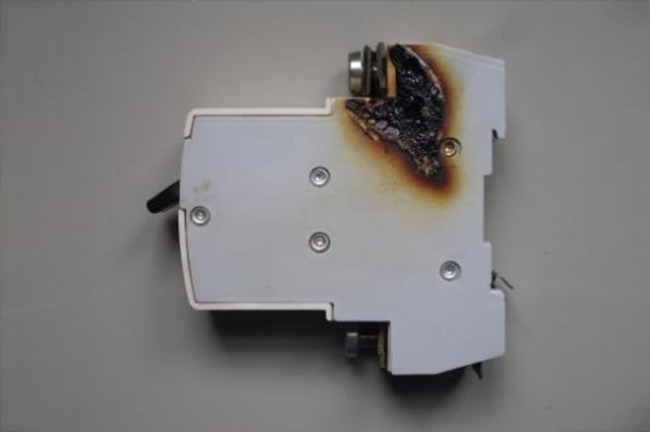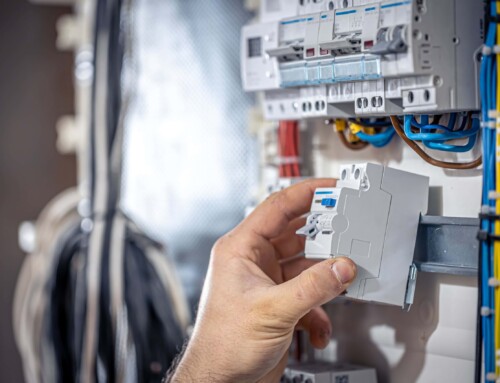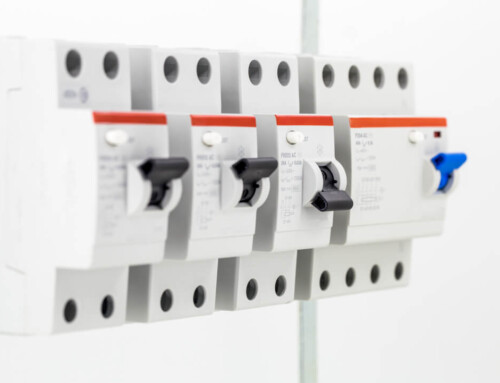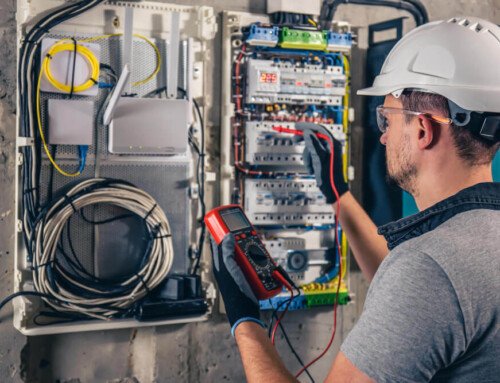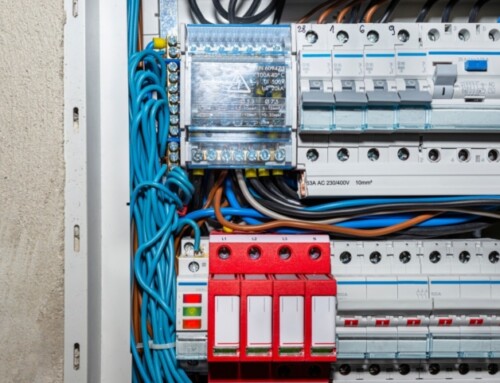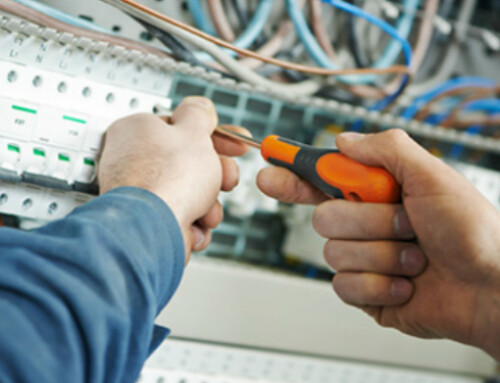Table of Contents
You are just going about your day, maybe doing laundry or heating something in the microwave, and suddenly, the power cuts out in part of the house. You head to your breaker panel, and sure enough, one of the switches has flipped again. Sound familiar?
A circuit breaker is a built-in safety feature that protects your electrical system from damage or, worse, a fire. If your circuit breaker keeps tripping, there is probably an issue that you need to resolve. This post breaks down why circuit breaker keeps tripping and what you can actually do about it.
What is a Circuit Breaker?
Think of a circuit breaker as a monitor for your home’s electrical system. It watches how much power is flowing through a certain circuit and shuts it down if something seems off, like too much current, a short, or even damaged wiring.
So when your house circuit breaker keeps tripping, it’s not just annoying. It’s a red flag. It’s telling you, “Hey, something’s not right here.”
What Causes a Circuit Breaker to Keep Tripping?
There are a few possible reasons your breaker is giving you a hard time. Let’s go through the most common ones. Some are simple, and others might need a pro to take a look.
- Overheating of Appliances
Sometimes, the issue isn’t your wiring. It’s one of your appliances. If something like a heater, air fryer, or even an old toaster is pulling more power than it should (or has internal damage), it can overheat the circuit and cause the breaker to trip.
How to spot it: Does the breaker trip right after you turn on a certain device? Unplug it and see if things stay stable. If so, that appliance might be the problem.
- Overloaded Circuits
Overloaded circuits are probably the most common reason for this mishap. Every circuit can only handle so much power. Plug in too many devices, especially high-wattage ones like space heaters, blow dryers, or vacuum cleaners, and you can easily push them past their limit.
Quick fix: Try plugging those items into different outlets across other circuits, or don’t use all of them at once. Basically, don’t ask one outlet to do the job of three.
- Short Circuit
This one’s more serious. A short circuit happens when a “hot” wire touches a neutral wire or another conductive surface. When that happens, the current goes wild, and the breaker shuts things down fast.
What to watch for: Burn marks, a strange smell, or if the breaker trips immediately after flipping it back on. If you see any of that, don’t mess with it. Call in an electrician.
- Ground Fault Surges
These are similar to short circuits but happen when a hot wire touches a grounded part of an appliance or outlet box. It often occurs in places with moisture, like kitchens, bathrooms, or laundry rooms. Modern homes usually have GFCI outlets to catch this kind of thing, but if yours are old or not working properly, that surge could trip your breaker.
Pro tip: Test your GFCI outlets regularly (there’s usually a test button). If they don’t respond, it’s time to replace them.
- Arc Fault
An arc fault is when electricity jumps from one wire to another, usually due to damaged or loose wires. It might not trip right away like a short circuit. However, over time, that sparking can cause heat and, potentially, a fire. AFCI breakers (Arc Fault Circuit Interrupters) are designed to detect this, but many older homes don’t have them.
Signs: Flickering lights, buzzing sounds, or outlets that feel warm. If you notice anything like that, don’t wait. Get it checked.
- Faulty Circuit Breaker
When your house circuit breaker keeps tripping for no reason, won’t reset properly, or feels hot, it could be the breaker, not the circuit, that’s faulty. Yup, sometimes the breaker itself is just bad. It might be worn out, damaged, or just plain old.
Call a pro: This is where it’s best to bring in a licensed electrician to inspect the panel.
What are the Signs That Your Breaker Might Be Failing?
Here’s how to tell if the circuit breaker is the issue, not the wiring or appliances:
- It trips without anything being plugged in
- The breaker won’t stay “on.”
- You notice a burning smell or see blackened spots
- It’s warm to the touch
- The panel is more than 20–30 years old
How to Fix a Circuit Breaker That Keeps Tripping?
Before you call in a pro, here are a few things you can try on your own.
- Ensure There is No Overloading
Unplug everything from the affected area. Reset the breaker. Then, plug items back in one at a time, turning each one on to see if something specific causes the trip. If
you hit the limit and the breaker trips again, you’ve probably got an overloaded circuit.
- Look for a Short Circuit
Inspect your plugs and outlets for signs of damage, burn marks, or odd smells. If anything looks off, stop. That’s likely a short circuit, and it needs professional attention.
- Test for Ground Fault
Use a GFCI tester if you’ve got one. They are cheap and easy to use. You can also test your GFCI outlets using the “Test” and “Reset” buttons. If it’s not working or keeps tripping, you’ve probably got a ground fault.
What to Do if Circuit Breaker Still Keeps Tripping?
If a circuit breaker keeps tripping even after trying the troubleshooting steps mentioned earlier, it’s best to get in touch with an electrician and have them look into it. In the meantime, for your safety, you can also try inspecting it yourself using these methods with appropriate caution.
- Unplug Devices: Manually switch off any devices and then unplug them. This is necessary because once the power surges back and the devices are still on, it might affect them adversely.
- Reset the Circuit Box: Go to the circuit breaker and switch it off or remove the fuse. Turn it on again. This is how you reset a circuit breaker.
- Check the Reasons: Inspect the circuit box again and check whether any of the above reasons tick the current situation of your circuit breaker.
- Switch on the Devices: You need to test the circuit by switching on all the lights and appliances you unplugged. This gives you an idea of what is causing the breaker to trip.
- Check or Replace: Once you check all the devices, decide whether you need to replace the circuit breaker with a new one.
Having your circuit breaker tripping isn’t just a random glitch. It’s your home trying to protect itself. Whether it’s an overloaded outlet, a faulty appliance, or something more serious like a ground fault or arc, it’s important to figure out the cause sooner rather than later. It helps you keep your house safe and prevent damage.
The good news? Once you know what’s causing it, it’s easy! Just make sure you are not ignoring the signs or brushing it off as “just something breakers do.” Remember, it is always advisable to call a licensed electrician if such issues persist.
If you need help sourcing quality circuit breakers, wiring, or other electrical materials, the team at D&F Liquidators has your back.
FAQs
- What is the purpose of a circuit breaker?
A circuit breaker is a safety device that cuts off the power supply when there is an overload or short circuit in the circuit. It prevents damage to electrical devices and wiring and protects people and property from electrical hazards.
- How does the circuit breaker work?
A circuit breaker works by detecting the amount of current flowing through the circuit. If it exceeds a certain limit, it trips and opens the circuit. This interrupts the flow of electricity and prevents damage to the circuit and electrical appliances. Once the fault has been cleared, the circuit breaker can be reset, and the power supply restored.
- What are the signs of a faulty circuit breaker?
Circuit breakers can develop faults over time. Look out for a burning smell, power outages in specific areas, frequent tripping, inoperable electrical outlets, scorch marks or damage on the circuit box, and a red light signalling a tripped breaker. Also, note if the breaker remains “OFF” or fails to stay in the reset mode.
- How do you reset the circuit breaker?
To reset a tripped circuit breaker, turn it off and then on again. Be sure to stand at a safe distance from the panel and wear safety goggles. Before unplugging devices, reset the breaker to determine the cause of the trip.
Remember that circuit breakers prevent overheating and electrical risks, so follow guidelines to keep your house safe. It is best to consult an electrician if you don’t understand it.
- What is the difference between a fuse and a circuit breaker?
Fuses and circuit breakers both protect electrical circuits from overloading or short-circuiting. Fuses contain a metal wire that melts when the current exceeds a certain limit.
At the same time, circuit breakers use an electromechanical switch that trips and disconnects the circuit. Fuses need to be replaced after they blow, while circuit breakers can be reset and reused.
- Is it dangerous if the circuit breaker keeps tripping?
If your circuit breaker keeps tripping, it could indicate a potentially dangerous electrical issue. It’s best to have a licensed electrician inspect your electrical system as soon as possible to identify and resolve the problem rather than continuing to reset the breaker. Ignoring the issue could lead to overheating, electrical fires, and other hazards.
- How do I fix a circuit breaker that keeps tripping?
To fix a circuit breaker that keeps tripping, try unplugging all devices connected to the circuit and resetting the breaker. If the issue persists, check for loose or damaged wires, reduce the amount of power being used on the circuit, or replace the old/damaged circuit breaker.
Remember, electrical work can be dangerous, so consider calling a licensed electrician for help if you are unsure.
- How to tell if a circuit breaker is bad?
If your circuit breaker trips frequently, feels hot to the touch, shows signs of physical damage or discoloration, or emits burning smells or popping sounds, it may be a sign that it needs to be replaced.
- Can I replace a circuit breaker myself?
While it’s possible to replace a circuit breaker yourself, electrical work can be dangerous. It should only be attempted by experienced individuals. If you are not confident in your abilities, it’s best to hire a professional electrician. Always turn off the power and follow safety precautions.

